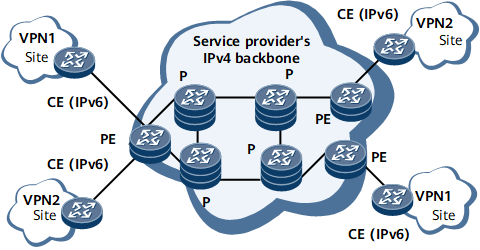BGP/MPLS IPv6 VPN Extension
On a BGP/MPLS IP VPN network, IPv4 routing protocols, such as BGP, OSPF, and IS-IS, run between PEs, and between PEs and CEs. After a VPN customer network transits from IPv4 to IPv6, the preceding routing protocols cannot be used between PEs and CEs. IPv6 VPN packets are transmitted on the backbone network. With BGP/MPLS IPv6 VPN extension, the backbone network can provide IPv6 VPN services for customers without having to be upgraded to an IPv6 network.

Solution using carriers' IPv4 backbone networks to carry IPv6 VPN services (also called the 6VPE solution)
Solution using carriers' IPv6 backbone networks to carry IPv6 VPN services
Currently, only the 6VPE solution is supported.
Figure 1 is the BGP/MPLS IPv6 VPN extension model. After BGP/MPLS IPv6 VPN extension is configured, IPv6 routing protocols run between PEs and CEs, and the following IPv6 routing protocols can be used to provide IPv6 VPN services:
BGP4+
Static IPv6 routes
OSPFv3
IS-IS IPv6
Routing Information Protocol next generation (RIPng)
IPv4 protocols can still run on the carriers' backbone networks that provide IPv6 VPN services between PEs. In this manner, the carriers' networks can smoothly transit from IPv4 to IPv6.
If the backbone network is an IPv4 network, IPv4 addresses are used to establish VPNv6 peers between PEs to transmit IPv6 VPN routes. IPv6 VPN routes can be carried over IPv4 tunnels on the backbone network to transmit IPv6 VPN services.
BGP/MPLS IPv6 VPN has the same principles and functions as BGP/MPLS IPv4 VPN, except that the routing protocols running between PEs and CEs are different.
